Forums › Laser Treatment Tips and Techniques › Soft Tissue Procedures › Fractured tooth w/ crown
- This topic is empty.
-
AuthorPosts
-
BenchwmerSpectatorEmergency patient from out of state.
Fell walking his dog. Crowned tooth #9 out. Tooth is vital.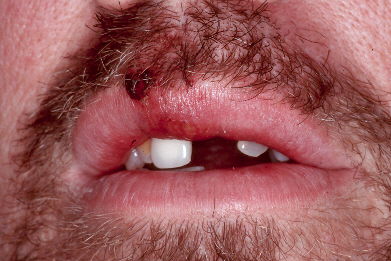
Cleaned tooth fragment out of existing crown. Will utilize root canal, post and core build-up retro-fit to existing crown, then re-cementing crown in place.
PerioLase MVP-7, free running, pulsed Nd:YAG will be use for troughing the crown margins and for hemostatis.Before treatmet
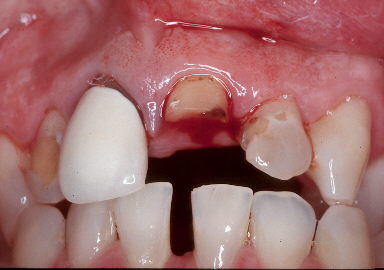
RCT therapy was performed. Gingival troughing was accomplished using the PerioLase pre-set of 3.6W 20Hz 250usec. This is a new pulse width setting for me. It is quick, it provides hemostatis with no charring or tissue recession. I now use this setting for all my crown and bridge for tissue retraction and hemostatis with no worry about tissue recession. Six years now, without using packing cord.
A Flexi-post Flange #1 was fitted so the crown could be reseated.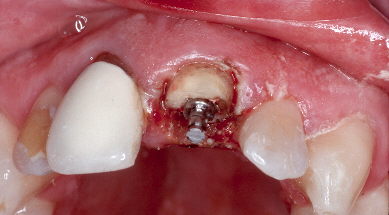
Internal surfaces of the crown were cleaned with air abrasion, then coated with Vaseline.
A self-etching DBA was used (Adper-Bond) on the tooth and in the root canal, a self-curing resin cement (3M Rely-X) was used for post cementation,a self-curing core paste was used (Lee Core paste) for the build-up.
The crown was seated, then removed after initial set.
Flashing of core paste was removed with a diamond. Ready for re-cementation.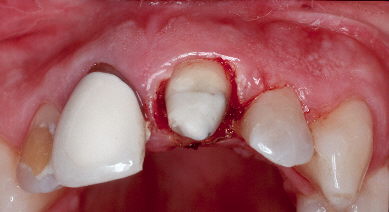
The crown was cleaned and cemented with 3M Uni-cem.
This patient has a boat-load of other dental problems and what should be immediate concerns. This one-visit procedure gave him back his smile, gave him a functioning crowned tooth and building blocks for future restoration of #8 and 9 with crown lengthening, other Perio, new crowns etc. for his dentist back home.
Jeff
(Edited by Benchwmer at 5:07 pm on July 19, 2005)
Robert Gregg DDSSpectatorJeff,
Very nice case.
250 usec for “wet” homostasis is a nice option when 650 is a bit too much in the anteriors huh?
Thanks for posting!
Bob
SwpmnSpectatorNice case.
Do you guys mind explaining physics/rationale behind shorter Pulse Duration for anterior vs. posterior teeth with Nd:YAG? Is it related to narrower facio/lingual dimensions of alveolar complex in the anterior?
What is “wet” hemostasis?
Thanks,
Robert Gregg DDSSpectatorAllen–
Pulse duration (time) approximately = zone/dimension (in microns) of thermal effect.
100 usec PD (time) approx = 100 microns (dimensional) zone of thermal effect
250 usec approx = 250 microns
etc……
So you are correct about your assumptions. One needs to be well trained/cautioned about using long PD in thin tissue/bone–like around anterior teeth vs bulky mandibular bone.
“Wet” hemostasis is a red thrombus that also contains fibrin. We also refer to it as a “stable fibrin clot” as such:
3 minutes immediately post op extraction and 650 usec long pulse duration (with one suture on the mesial due to torn tissue). NOTE: the grey fibrin strands coarsing through the clot, and the areas of thrombi.
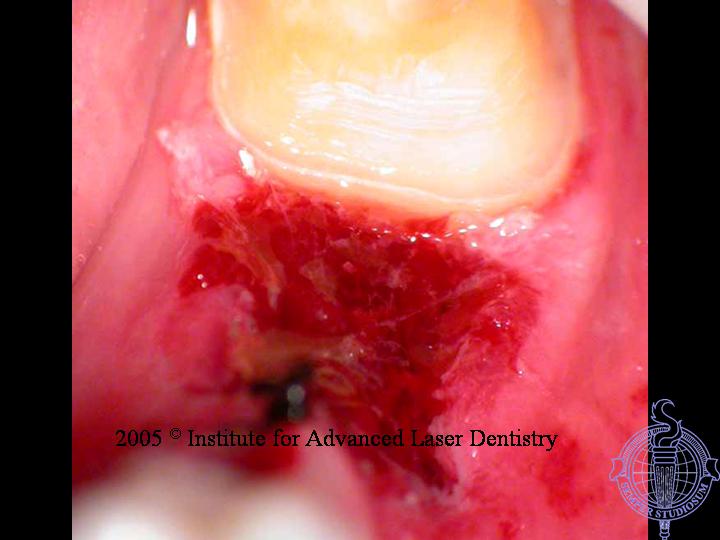
Thanks for the great question.
Bob
(Edited by Robert Gregg DDS at 12:25 am on July 22, 2005)
SwpmnSpectatorThanks, Robert, that was most helpful.
Al
-
AuthorPosts
